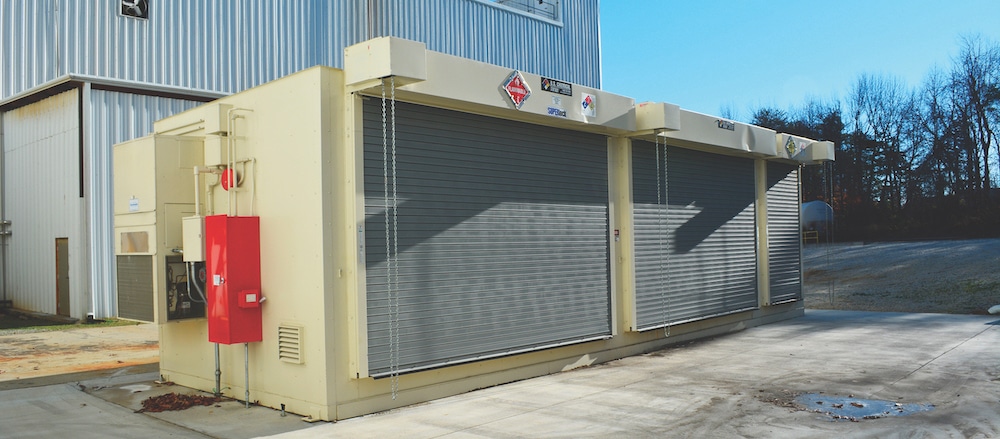
Paints are considered “flammable and combustible materials” according to
OSHA. Storing large volumes of paint can be extremely dangerous; avoiding safe paint storage requirements may result in fines and other penalties. Proper
paint storage buildings like those engineered by
U.S. Chemical Storage can help protect personnel and facilities that handle, store, mix and dispense paints and other flammable liquids.
Paint or other flammable liquid storage that exceeds 60 gallons must be stored in a paint storage building to protect flammable liquids against flash fire, prevent paint containers from building excessive internal pressure and contain flammable liquid spills or leaks.
Depending on their location in relation to other buildings or property lines, indoor and outdoor storage buildings may require a heavy-duty fire-rated construction listed by the National Fire Protection Agency (NFPA 251-1969). OSHA requires all indoor paint storage buildings to contain the following:
- An automatic fire suppression system – either water sprinkler or dry chemical (depending on your paint or solvent)
- Fusible links will automatically release the agent through a distribution piping network located on the ceiling
- Sized for your flammable chemical volume
- Can also be customized with strobes and alarms
- A mechanical ventilation system
- Allow for a minimum of six air changes per hour
- controlled by a switch located outside the building
- explosion-proof ventilation options are available
- A clear aisle at least 3 feet wide for safe egress from the building
Paints contain additives, pigments, and chemicals that can be harmful to humans and the environment if not stored of properly. Paint waste, whether liquid or solid, must be properly contained in a flammable storage space for paint that can handle proper flammables and hazardous materials.
RELATED ARTICLE: What You Need to Know About Flammable Paint Storage Buildings
Safe Paint Chemical Storage Buildings

There are two major types of paint: oil-based and water-based paints. Water-based paints include latex and acrylic paints, which are not generally considered to be flammable. However, some water-based paints
can be flammable when in a spray form due to the propellant used. You must consult the Safety Data Sheet (SDS) to be aware of these properties.
Oil-based paints are manufactured with a petrochemical product, usually mineral spirits or toluene, as a solvent. These paints include enamels, shellacs, alkyd, lacquers, stains, seals, polyurethanes, and more. Solvents are also used to clean up these paints, and they are also flammable.
It is obvious that some paints are more flammable than others and some are more toxic than others. However, it is necessary that paint classifications are grouped separately to avoid hazardous situations. Grouping paints according to the NFPA 704 hazard classifications can provide for a safe and compliant chemical storage environment. NFPA classifies paint as a Category 3 Flammable substance.
Fully understanding the Safety Data Sheet (SDS). Any chemical should come with an SDS from the manufacturer. Copies of this important document should be kept on file in a safe location where everyone involved with the product can have access in case of an accident or emergency.
There are 16 sections to every SDS. Below are 7 key sections that can help in the design and placement of your chemical storage building:
- Section 1 – Name of the chemical and any other names by which it’s known, the general purpose of the chemical, and the manufacturer
- Section 2 – Hazards of the chemical and the warning info
- Section 4 – First aid measures for various types of exposure
- Section 5 – Fire-fighting recommendations
- Section 6 – Recommended procedures for clean up of spills, leaks, and unintentional release
- Section 7 – Handling and storage safety
For additional information on how to read a Safety Data Sheet – visit the
OSHA website or download their helpful PDF that outlines what is the information found in each of the 16 sections
“Hazard Communication Standard: Safety Data Sheets”.
If you’re storing more than 60 gallons of solvent-based paint indoors or outdoors, you are required to store it in a specially constructed storage space or in a “plug & play” prefabricated chemical storage building that meets fire protection standards. When storing paint in your facility it is necessary that precautionary measures are met. Keeping your paints stored in a fire-rated chemical storage building allows for full compliance.
RELATED ARTICLE: Don’t Paint Yourself into a Corner, Use Safe Storage Buildings
Whether storing paint containers or waste,
flammable chemical storage buildings by U.S. Chemical Storage offer a safe and protected storage solution. Customize your paint storage locker with shelving,
racks and
exhaust systems to keep paint inventory safe and secure. Our buildings are designed to handle large volumes or small volumes of hazardous chemicals.
Meet all safe paint storage requirements by customizing your building with our full line of
chemical storage accessories. Options include explosion-proof electrical items such as interior lights, exhaust fans, heating, cooling, fire suppression, spill detectors, gas sensors and more.
SuperLoc 4-Hour Fire-Rated Chemical Storage Buildings
Keep your flammable chemical storage paint container within 10 feet of or even inside your facility with a
SuperLoc chemical storage buildingthat is a 4-hour bi-directional fire rated building for ultimate protection.
The SuperLoc chemical storage locker provides superior strength and safety when keeping paint storage maintained and compliant. All pre-fabricated steel buildings feature a leak-tested secondary sump containment for spill protection and leak protection and can be engineered to meet all safe paint storage requirements.
Paint Storage Tips – Achieve Full Compliance
- Keep an updated inventory on all paints that are being stored.
- Label paints by contents and hazard classifications.
- Store paints out of the reach of children or other entrants.
- Keep possible contaminants away from any paint inventory.
- Maintain room temperature inside your flammable storage container.
- Keep paint storage away from extreme temperatures.
- Dispose of paints in a household hazardous waste building or collection site.
- Label your flammable paint storage building with proper hazard classifications.
Order Your Paint Storage Building Today
Keep your paint inventory safe and compliant with customizable paint storage buildings from by
U.S. Chemical Storage. Constructed by our professional engineers and experienced, certified welders for maximum strength and dependability, every paint storage building is tested before it leaves the factory for complete quality assurance. Contact us today for a
free quote.

 Paints are considered “flammable and combustible materials” according to OSHA. Storing large volumes of paint can be extremely dangerous; avoiding safe paint storage requirements may result in fines and other penalties. Proper paint storage buildings like those engineered by U.S. Chemical Storage can help protect personnel and facilities that handle, store, mix and dispense paints and other flammable liquids.
Paint or other flammable liquid storage that exceeds 60 gallons must be stored in a paint storage building to protect flammable liquids against flash fire, prevent paint containers from building excessive internal pressure and contain flammable liquid spills or leaks.
Depending on their location in relation to other buildings or property lines, indoor and outdoor storage buildings may require a heavy-duty fire-rated construction listed by the National Fire Protection Agency (NFPA 251-1969). OSHA requires all indoor paint storage buildings to contain the following:
Paints are considered “flammable and combustible materials” according to OSHA. Storing large volumes of paint can be extremely dangerous; avoiding safe paint storage requirements may result in fines and other penalties. Proper paint storage buildings like those engineered by U.S. Chemical Storage can help protect personnel and facilities that handle, store, mix and dispense paints and other flammable liquids.
Paint or other flammable liquid storage that exceeds 60 gallons must be stored in a paint storage building to protect flammable liquids against flash fire, prevent paint containers from building excessive internal pressure and contain flammable liquid spills or leaks.
Depending on their location in relation to other buildings or property lines, indoor and outdoor storage buildings may require a heavy-duty fire-rated construction listed by the National Fire Protection Agency (NFPA 251-1969). OSHA requires all indoor paint storage buildings to contain the following:
 There are two major types of paint: oil-based and water-based paints. Water-based paints include latex and acrylic paints, which are not generally considered to be flammable. However, some water-based paints can be flammable when in a spray form due to the propellant used. You must consult the Safety Data Sheet (SDS) to be aware of these properties.
Oil-based paints are manufactured with a petrochemical product, usually mineral spirits or toluene, as a solvent. These paints include enamels, shellacs, alkyd, lacquers, stains, seals, polyurethanes, and more. Solvents are also used to clean up these paints, and they are also flammable.
It is obvious that some paints are more flammable than others and some are more toxic than others. However, it is necessary that paint classifications are grouped separately to avoid hazardous situations. Grouping paints according to the NFPA 704 hazard classifications can provide for a safe and compliant chemical storage environment. NFPA classifies paint as a Category 3 Flammable substance.
Fully understanding the Safety Data Sheet (SDS). Any chemical should come with an SDS from the manufacturer. Copies of this important document should be kept on file in a safe location where everyone involved with the product can have access in case of an accident or emergency.
There are 16 sections to every SDS. Below are 7 key sections that can help in the design and placement of your chemical storage building:
There are two major types of paint: oil-based and water-based paints. Water-based paints include latex and acrylic paints, which are not generally considered to be flammable. However, some water-based paints can be flammable when in a spray form due to the propellant used. You must consult the Safety Data Sheet (SDS) to be aware of these properties.
Oil-based paints are manufactured with a petrochemical product, usually mineral spirits or toluene, as a solvent. These paints include enamels, shellacs, alkyd, lacquers, stains, seals, polyurethanes, and more. Solvents are also used to clean up these paints, and they are also flammable.
It is obvious that some paints are more flammable than others and some are more toxic than others. However, it is necessary that paint classifications are grouped separately to avoid hazardous situations. Grouping paints according to the NFPA 704 hazard classifications can provide for a safe and compliant chemical storage environment. NFPA classifies paint as a Category 3 Flammable substance.
Fully understanding the Safety Data Sheet (SDS). Any chemical should come with an SDS from the manufacturer. Copies of this important document should be kept on file in a safe location where everyone involved with the product can have access in case of an accident or emergency.
There are 16 sections to every SDS. Below are 7 key sections that can help in the design and placement of your chemical storage building:
